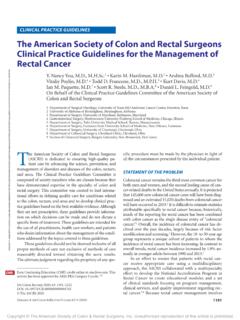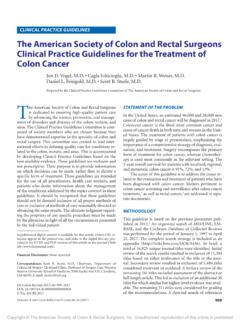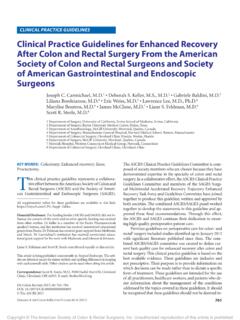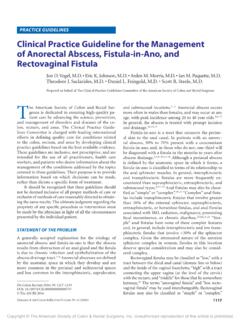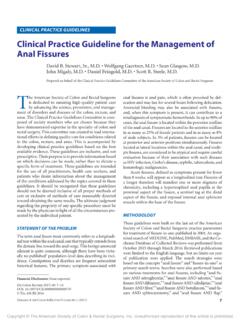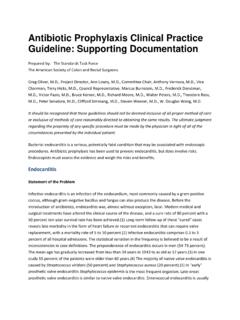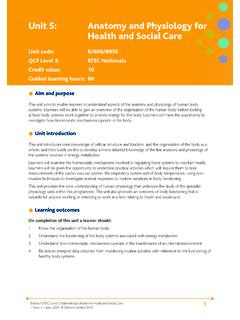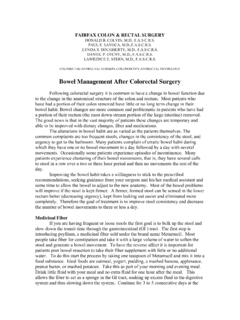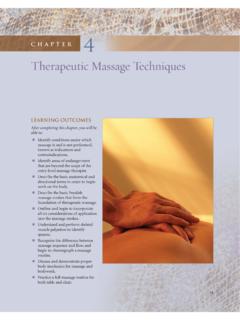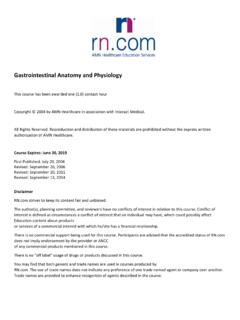Transcription of The American Society of Colon and Rectal Surgeons ...
1 CLINICAL PRACTICE GUIDELINES. The American Society of Colon and Rectal Surgeons '. Clinical Practice Guideline for the Evaluation and Management of Constipation Ian M. Paquette, Madhulika Varma, Charles Ternent, Genevieve Melton-Meaux, Janice F. Rafferty, Daniel Feingold, Scott R. Steele, T. he American Society of Colon and Rectal Surgeons for functional constipation include at least 2 of the fol- is dedicated to assuring high-quality patient care lowing symptoms during 25% of defecations: straining, by advancing the science, prevention, and manage- lumpy or hard stools, sensation of incomplete evacuation, ment of disorders and diseases of the Colon , rectum, and sensation of anorectal obstruction or blockage, relying on anus. The Clinical Practice Guidelines Committee is com- manual maneuvers to promote defecation, and having less posed of Society members who are chosen because they than 3 unassisted bowel movements per ,8 These cri- have demonstrated expertise in the specialty of Colon and teria include constipation related to the 3 common sub- Rectal surgery.
2 This committee was created to lead inter- types: colonic inertia or slow transit constipation, normal national efforts in defining quality care for conditions re- transit constipation, and pelvic floor or defecation dys- lated to the Colon , rectum, and anus. This is accompanied function. However, in reality, many patients demonstrate by developing Clinical Practice Guidelines based on the symptoms attributable to more than 1 constipation sub- best available evidence. These guidelines are inclusive and type and to constipation-predominant IBS, as well. The not prescriptive. Their purpose is to provide information etiology of constipation is multifactorial and can include on which decisions can be made rather than to dictate a extrinsic factors such as diet, medications, metabolic or specific form of treatment.
3 These guidelines are intended neurologic disorders, and psychosocial issues, as well as in- for the use of all practitioners, healthcare workers, and trinsic factors mentioned above. The variable nature and patients who desire information about the management severity of constipation symptoms require an individual- of the conditions addressed by the topics covered in these ized approach to evaluation and treatment. Constipation guidelines. It should be recognized that these guidelines is most commonly managed by primary care physicians should not be deemed inclusive of all proper methods of and gastroenterologists, with Colon and Rectal Surgeons care or exclusive of methods of care that are reasonably usually becoming involved for more complicated cases. A. directed to obtaining the same results. The ultimate judg- collaborative approach across specialties is often needed to ment regarding the propriety of any specific procedure achieve optimal outcomes.
4 Must be made by the physician in light of all of the cir- cumstances presented by the individual patient. METHODOLOGY. STATEMENT OF THE PROBLEM These guidelines are an update of the previous edition of The American Society of Colon and Rectal Surgeons prac- Constipation is a benign condition that can have a signifi- tice parameters for treatment of constipation published cant impact on quality of life. The prevalence has been es- in An organized search of MEDLINE, PubMed, timated to be as high as 30% in select populations and has and the Cochrane Database of Collected Reviews was been noted to be higher in women, nonwhites, those aged performed through June 2015. Key-word combinations >65 years, and those with lower socioeconomic 6 included constipation, obstructed defecation, slow transit, Constipation is characterized by dysfunction of colonic surgery, rectocele, Rectal intussusception, pelvic dyssynergia, motility and the defecation process.
5 The Rome III criteria anismus, paradoxical puborectalis, megacolon, megarectum, and related articles. Directed searches of the embedded Dis Colon Rectum 2016; 59: 479 492 references from primary articles were also performed. DOI: The primary authors reviewed all of the English language The ASCRS 2016 articles and studies in adults, systematic reviews, and Diseases of the Colon & Rectum Volume 59: 6 (2016) 479. Copyright The American Society of Colon & Rectal Surgeons , Inc. Unauthorized reproduction of this article is prohibited. 480 Paquette et al: Constipation Practice Guideline meta-analyses. Recommendations were formulated by need to be stopped or modified. Patients may also have the primary authors and reviewed by the entire Clinical an associated or undiagnosed psychiatric, neurologic, or Practice Guidelines Committee.
6 The final grade of recom- endocrine disorder that will require treatment to help mendation was performed using the Grades of Recom- address constipation Lastly, a careful assess- mendation, Assessment, Development, and Evaluation ment of symptoms may help distinguish among consti- system10 (Table 1) and approved by the entire Clinical pation subtypes. Those with infrequent, hard stools may Practice Guidelines Committee. be more likely to have colonic inertia, whereas those with incomplete evacuation and straining are more likely to Evaluation of Constipation have pelvic floor dysfunction. The presence of abdominal 1. A directed history and physical examination should be pain may indicate IBS. However, the history alone may be performed in patients with constipation. Grade of Rec- inadequate to clearly establish a diagnosis, because many ommendation: Strong recommendation based on low- or patients will have symptoms associated with more than 1.
7 Very-low-quality evidence, 1C subtype. Although constipation is a benign condition, a thorough The physical examination is directed at the abdomi- history and physical examination can help ensure that nal and anorectal components. Generally the abdomen a serious life-threatening disease is not the underlying is nontender but may be remarkable for distension or cause of the constipation. Patients who also report Rectal discomfort with palpation. External anorectal exami- bleeding, change in caliber of stools, blood in the stool, nation includes the evaluation for an anal wink and the weight loss, anemia, or a family history of colorectal can- presence of stool staining or excoriation, hemorrhoids, cer should be evaluated for a colorectal malignancy that full-thickness or mucosal Rectal prolapse, and fissures.
8 May be causing ,12 In addition, a careful his- Digital Rectal examination can reveal the presence of tory may elicit modifiable behavioral factors, such as diet, anal hypertonia, poor incremental squeeze, paradoxical dehydration, or immobility, as well as medications that puborectalis contraction, rectocele, anorectal masses, may be contributing to ,11 Opioids, antide- stricture, or fecal impaction that can be associated with pressants, anticholinergics, calcium channel blockers, and constipation. In particular, a Valsalva maneuver should calcium supplements are commonly implicated and may be done to diagnose a rectocele, prolapse, pelvic floor TABLE 1. The GRADE system: grading recommendations Methodologic quality of No. Description Benefit vs risk and burdens supporting evidence Implications 1A Strong recommendation, Benefits clearly outweigh risk and RCTs without important limitations Strong recommendation, can high-quality evidence burdens or vice versa or overwhelming evidence from apply to most patients in observational studies most circumstances without reservation 1B Strong recommendation, Benefits clearly outweigh risk and RCTs with important limitations Strong recommendation, can moderate-quality burdens or vice versa (inconsistent results, methodologic apply to most patients in evidence flaws, indirect, or imprecise)
9 Or most circumstances without exceptionally strong evidence reservation from observational studies 1C Strong recommendation, Benefits clearly outweigh risk and Observational studies or case series Strong recommendation but low- or very-low-quality burdens or vice versa may change when higher- evidence quality evidence becomes available 2A Weak recommendation, Benefits closely balanced with risks RCTs without important limitations Weak recommendation, best high-quality evidence and burdens or overwhelming evidence from action may differ depending observational studies on circumstances or patient or societal values 2B Weak recommendations, Benefits closely balanced with risks RCTs with important limitations Weak recommendation, best moderate-quality and burdens (inconsistent results, methodologic action may differ depending evidence flaws, indirect, or imprecise) or on circumstances or patient exceptionally strong evidence or societal values from observational studies 2C Weak recommendation, Uncertainty in the estimates of Observational studies or case series Very weak recommendations.
10 Low- or very-low-quality benefits, risks and burden; other alternatives may be evidence benefits, risks, and burden may equally reasonable be closely balanced Adapted with permission from Chest. 2006;129:174 181. GRADE = Grades of Recommendation, Assessment, Development, and Evaluation; RCT = randomized controlled trial. Copyright The American Society of Colon & Rectal Surgeons , Inc. Unauthorized reproduction of this article is prohibited. Diseases of the Colon & Rectum Volume 59: 6 (2016) 481. descent, or puborectalis dysfunction. Anoscopy or rigid 4. Anorectal physiology and Colon transit investigations proctoscopy, although not necessary, may also be helpful may help identify the underlying etiology and are useful to evaluate internal hemorrhoids, proctitis, or masses. In in patients with refractory constipation.

